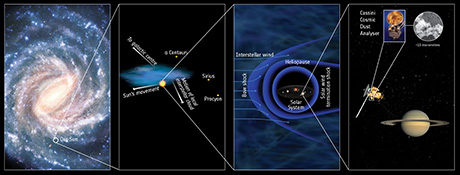Heidelberg Researchers Analyse Chemical Composition of Dust from Beyond the Solar System
14 April 2016
EMBARGO TIME: Thursday, 14 April 2016, 8pm (MEZ) / 6 pm (GMT)

Graphics: ESA
The Cosmic Dust Analyser on the international Cassini spacecraft has detected the faint but distinct signature of dust coming from outside our Solar System, from the local interstellar cloud: an almost empty bubble of gas and dust we are travelling through with a distinct direction and speed.
This graphic summarises the location of Saturn, and the Solar System, with respect to the local interstellar cloud, and our place in the Milky Way galaxy.
A Heidelberg-designed dust detector on the Cassini space probe – known as the cosmic dust analyser (CDA) – has identified several extremely rare and minuscule particles of interstellar dust from outside our solar system, and examined their chemical composition. Surprisingly it turns out that the different dust particles are very similar in composition and have collected the whole element mix of the cosmos. The experts therefore suspect that dust is continually destroyed, reformed and thereby homogenised in the „witch’s cauldron“ of outer space. The results of an international research team, including scientists from the Institute of Earth Sciences and the Klaus Tschira Laboratory for Cosmochemistry of Heidelberg University, are published in „Science“.
„Interstellar dust is one of the last bastions of the unknown in space, its individual particles being only about 200 nanometres in size and very hard to find,“ explains Prof. Dr. Mario Trieloff, earth scientist from Heidelberg University. The dust is part of the interstellar material consisting of gas and helium, as well as heavy metals, and which can arise from the condensation processes of stars and planets. These particles are the raw material that were the main building blocks for the earth and other terrestrial planets.
When it comes to studying interstellar dust, science has so far depended on particles reaching our solar system. The Stardust space probe was already able to capture particles of the very weak flux crossing our solar system. „But these particles were unusually large, so the research findings are possibly not representative,“ Prof. Trieloff says. By contrast, the Cassini probe could identify 36 particles of interstellar dust among millions of planetary dust particles. Furthermore the CDA is in a position to analyse them on the spot with the assistance of mass spectrometry. This has enabled much more precise results than before.
Dr. Frank Postberg, on a Heisenberg grant at the Institute for Earth Science, notes that mass spectrometric measurements can now be made for the first time on „a statistically significant quantity of such dust particles“. This process had only become possible through a complex series of tests conducted in Heidelberg to calibrate laboratory models of the CDA. To achieve this aim, silicate dust had to be accelerated in the laboratory to upwards of 40 km a second, which is roughly the speed of interstellar dust.
„The result of the measurements was truly amazing,“ Dr. Postberg reports. „The 36 particles of interstellar origin, that are very similar in their composition, contain a mix of the most important rock-forming elements – magnesium, iron, silicon and calcium – in average cosmic abundance. Although a dust particle has a mass of less than a trillionth of a gram, the whole element mix of the cosmos is collected there, with the exception of very volatile gases. Such particles cannot be found in our solar system.“ Most scientists had expected dust populations with different compositions, corresponding to the different processes of origin in atmospheres of dying stars. These differences are also found in the stellar dust of meteorites, which is highly individual in its isotope composition. „Our data tells a completely different story,“ he underlines.
According to the scientists, the dust has lost its individuality because it was homogenised in the cosmic „witch’s cauldron“ of the interstellar medium. It contains gigantic, million-degree hot bubbles of supernova explosions, whose edges arise from shock fronts expanding at hundreds of kilometres per second, explains Dr. Nicolas Altobelli, who is the first author and a scientist at the European Space Agency (ESA). There had already been a theory, he says, that interstellar dust can survive this energy-rich environment for only a few hundred million years and that very few „lucky survivors“ succeed in reaching newly forming planetary systems as intact stellar dust. The latest research results now confirm that most particles are destroyed and reformed in molecular clouds, i.e. cool, dense regions of outer space. Interstellar winds bring these particles as homogenised dust into our solar system.
The CDA was developed by scientists from the German Aerospace Centre (DLR), the Max Planck Institute for Nuclear Physics in Heidelberg and the University of Kent, Canterbury campus (United Kingdom). DLR and ESA support the operation of this instrument. Project leader is Dr. Ralf Srama from Stuttgart University. Dr. Postberg and Prof. Trieloff direct the chemical analyses. Support for the research came from the Klaus Tschira Foundation.

